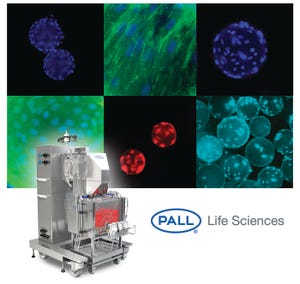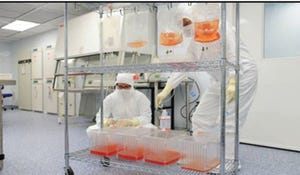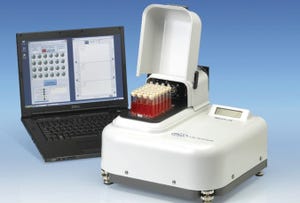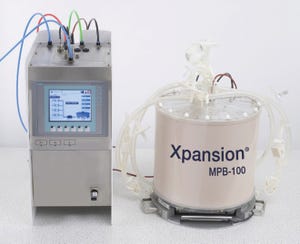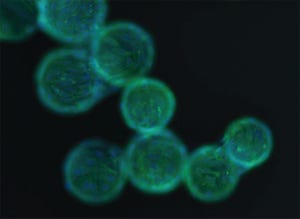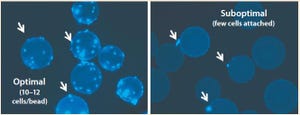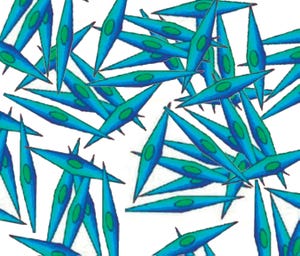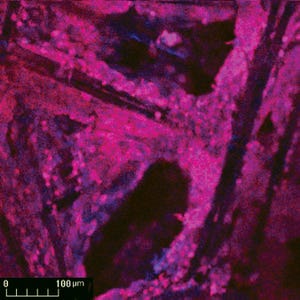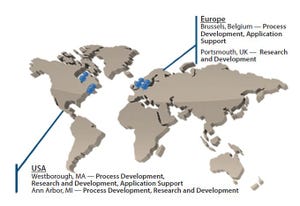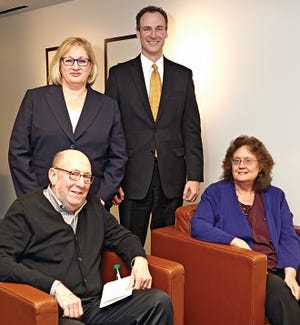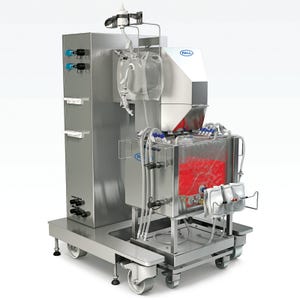Pall 2015 Special Report
As this special Pall supplement of
BioProcess International
issue goes to press, progress continues in the field of cell therapy research. The revival of cell (and gene) therapy has been driven by some positive achievements that have occurred over the past decade.
Cell therapy products differ in many ways from traditional small-molecular and biologic products. The main difference is that, contrary to traditional biopharmaceutical applications in which cells secrete the product of interest, in cell therapy applications cells are the product. That brings a multitude of challenges as manufacturers navigate the industrialization pathway to determine an optimal manufacturing strategy for their therapy.
Read the full text of this article in the PDF (Login required).
On 12 March 2015, BPI met with Mario Philips, president, single-use technologies, at Pall’s Port Washington, NY, facility, to learn about Pall’s reasons for entering the cell therapy market. Also participating in the discussion was Alain Fairbank, director of marketing for cell therapies at Pall Life Sciences.
Read the full text of this article in the PDF (Login required).
Adherent cells such as adult primary cell lines and human multipotent (MSCs) and pluripotent stem cells (hPSCs) present a manufacturing challenge as lot sizes increase from 10
9
(billions) to 10
12
(trillions) cells (
1
). Typically, manufacturing platforms are good for one log of expansion. So new methods will be required to achieve commercially relevant lot sizes. Traditional two-dimensional culture methods have been used to grow anchorage-dependent cell types. Although such methods are reliable and well defined, they are very labor intensive and limited in scale-up production potential by the available growth surface area (Table 1). Allogeneic “off-the-shelf” therapies based on adherent-cell platforms may require manufactured lot sizes from 100 billion to a trillion cells depending on a given indication’s market size (
2
).
Read the full text of this article in the PDF (Login required).
Cell therapy promises revolutionary new therapeutic treatments for cancer and other serious diseases and injuries. For example, T-cell therapy response rates of >50% and durable complete response rates of 20% have been reported in patients with metastatic melanoma who had failed other therapies (
1
). In another example, sustained remissions of up to a year were achieved among a small group of advanced chronic lymphocytic leukemia patients upon treatment with autologous T-cells expressing an anti-CD19 chimeric antigen receptor (
2
). Numerous other examples use cell therapy for cardiac repair, bone or cartilage regeneration, organ repair (pancreas or liver), neurological repair (spinal cord or brain injury), correcting genetic defects, and treating infectious diseases such as human immunodeficiency virus (HIV) (
3
).
Read the full text of this article in the PDF (Login required).
Cell-based products are becoming increasingly important as potential biotherapies. Cell therapy is predicted to have a huge impact on the healthcare sector over the coming decades. Stem cells, in particular, are investigated as potential treatments for a diverse range of applications (such as heart disease and metabolic and inflammatory disorders) in which they might be used to restore lost biological functions.
Read the full text of this article in the PDF (Login required).
Mesenchymal stem cells (MSCs) are self-renewing cells that differentiate into several terminally differentiated cell types. These cells have been isolated from multiple sources such as bone marrow, adipose tissue, peripheral blood, and other adult tissues(
1
–
6
). The interest in these cells is that they hold the potential to cure disease and are being pursued in clinical trials. Three emerging fields of interest for stem cells are cell therapy, regenerative medicine and screening of candidate drugs. In many cases, poor correlation between efficacy of candidate drugs in animal models and humans is observed. This leads to high attrition rates of candidate drugs from the developmental pipeline and also contributes to large losses in revenue spent on animal model testing.
Read the full text of this article in the PDF (Login required).
The process of delivering an allogeneic stem-cell therapy to patients requires isolation and expansion of rare tissue-specific stem cells, which are subsequently delivered to individual patients for treatment. One type of cell used for such therapies is commonly known as human mesenchymal stem cells (hMSCs). They have been isolated from a number of tissues: e.g., bone marrow, heart, brain, placenta, and umbilical cord. And they have been shown to be immune-privileged in that hMSCs elicit no graft-versus-host (GvH) response such as those observed with allogeneic organ transplants.
Read the full text of this article in the PDF (Login required).
Rapid progress is occurring in the field of stem cell therapy research, and increasing numbers of products will begin reaching the market in the near future. But new cell therapy treatments must fit into a competitive and highly regulated healthcare environment. Succeeding in that environment requires alignment between a company’s business model and its manufacturing strategy.
Read the full text of this article in the PDF (Login required).
Sponsored Content
Production of Viral Vectors Using the iCELLis® Fixed-Bed Bioreactor System: Beyond Mesenchymal Stem Cells — Gene-Modified Cell Therapy, Gene Therapy, and ExosomesProduction of Viral Vectors Using the iCELLis® Fixed-Bed Bioreactor System: Beyond Mesenchymal Stem Cells — Gene-Modified Cell Therapy, Gene Therapy, and Exosomes
In the past few years, the resurgence of cell-based immunotherapies — and, by extension, gene therapies — has accelerated as products move rapidly from academic research laboratories into commercial development. A successful clinical trial by St. Jude Children’s Research and the University College London of a gene therapy for hemophilia B was a seminal translational event (
1
), as was the licensing of the University of Pennsylvania’s gene-modified chimeric antigen receptor T-cell technology (CAR-T) for leukemia by Novartis (
2
). CAR-T cells and gene therapies are now among the most dynamic areas for biotechnology investment and development. Both gene therapies and gene-modified cell therapies require large amounts of viral vectors, either for direct delivery to patients or for ex vivo modification of cells that are later dosed to patients.
Read the full text of this article in the PDF (Login required).
Cell-based therapies hold promise for treating many acute and chronic diseases (
1
). Optimism surrounding that therapeutic potential has driven the initiation of multiple clinical trials in pursuit of such treatments. Procedures for preparing these therapeutic agents begin with selective isolation of cells from desired tissues. That is followed by ex vivo expansion of cells of desired phenotype and functionality. Once expanded to acceptable levels, cells are stored to preserve their viability during transportation to treatment facilities. The final step in the process of cell therapy treatment involves infusion of cells into patients through a number of administration routes (
2
,
3
).
Read the full text of this article in the PDF (Login required).
Pall Life Sciences has long been known for its expertise in processing and filtration equipment for the biopharmaceutical industry. In recent years, the company has broadened its offerings in upstream manufacturing by expanding its core capabilities in the single-use, bioreactor, and microcarrier arenas, with unique and innovative technologies for cultivation of cells to be used as therapies.
Read the full text of this article in the PDF (Login required).
On 12 March 2015, BPI publisher Brian Caine and editor in chief Anne Montgomery spoke with Harvey Brandwein, Pall’s vice president of business development, at the company’s Port Washington, NY, facility. Pall’s director of marketing for cell therapies, Alain Fairbank, also provided her thoughts on the evolution of tools and technologies for this market sector.
Knowing that this interview would become one of the concluding chapters in Pall’s special issue with BPI, we reviewed a number of topics covered earlier, asking Brandwein to comment about how all these elements need to come together to advance the business case for cell-based therapies. We began by asking him about his responsibilities at Pall and how his experiences in the broader biotechnology industry have shaped his perspectives.
Read the full text of this article in the PDF (Login required).
Sponsored Content
Accelerator Development Services
Applications:
Bioprocess consulting, process development, and qualification
Features:
Pall Life Sciences supports customers with an experienced team of scientists and engineers — from on-site guidance to larger projects in its own process development laboratories.
PadReactor® Single-Use Bioreactors
Applications:
Flexible for suspension- adapted and adherent cell cultures
Features:
The PadReactor family of single-use bioreactors is designed for cell culture applications. These systems are linearly scalable (5–1,000 L) and suited from laboratory-scale process development to large-scale GMP manufacturing. They are proven to be effective for cultivation of suspended cells and adherent cells on microcarriers (e.g., Pall SoloHill® microcarriers).
SoloHill® Microcarrier Training Courses
Applications:
Promotes efficient user acquisition of microcarrier operational skills
Features:
SoloHill microcarrier training courses are offered at Pall’s sites in Ann Arbor, MI (USA), an...
Subscribe to receive our monthly print or digital publication
Join our 70,000+ readers. And yes, it's completely free.
